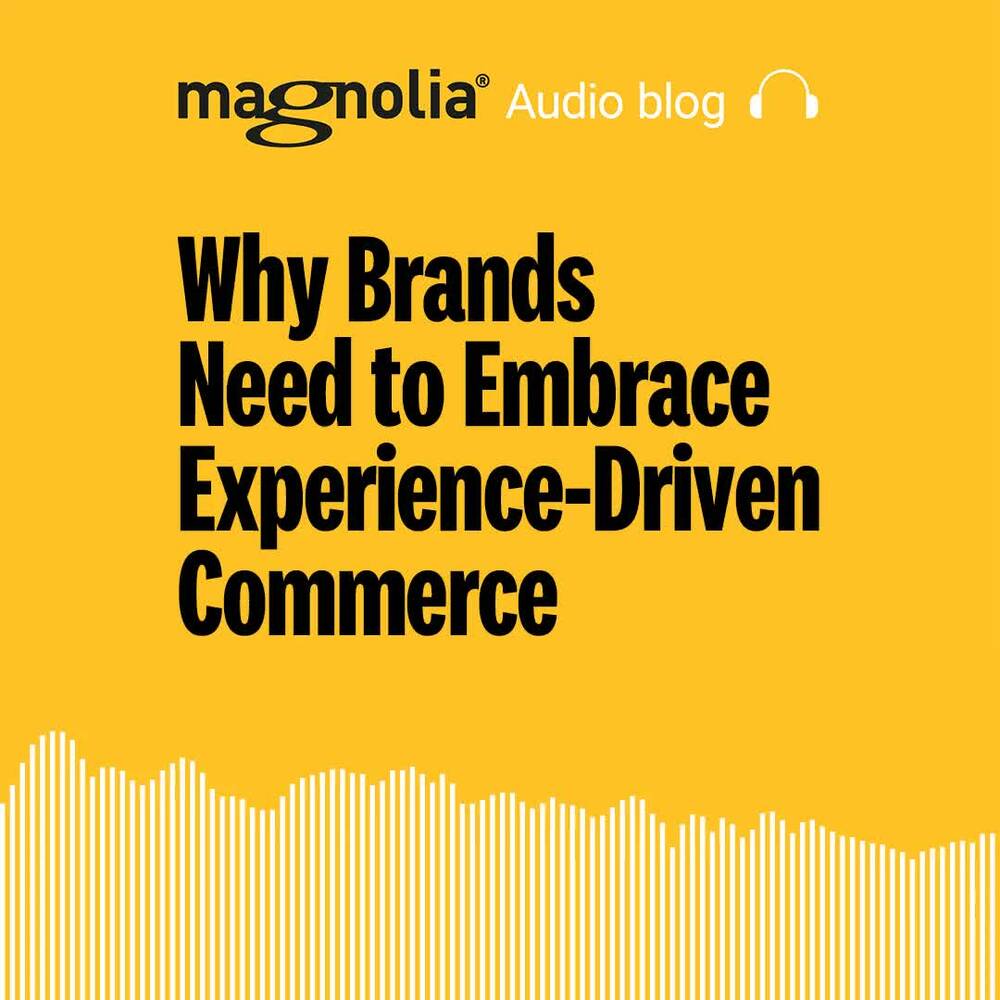- Jun 10, 2024
- 8 min
Why Brands Need to Embrace Experience-Driven Commerce
Magnolia in action
Take 12 minutes and a coffee break to discover how Magnolia can elevate your digital experience.
Consumers have higher and higher expectations from brands throughout their entire journey from discovery to purchase, both online and offline. Experience-driven commerce combines data, analytics, and the right type of content for each touchpoint to offer customers a personalized, omnichannel, and seamless experience.
Experience-driven commerce offers several benefits for both businesses and customers: higher loyalty, better conversion rates, and improved customer satisfaction. All these combined lead to increased revenue and business growth.
A digital experience platform (DXP), such as Magnolia, equips marketers with the necessary tools and provides the technological foundation necessary for delivering a commerce model that is built around the consumer. Discover how Magnolia can help marketers combine data and content into a personalized experience to leverage the benefits of experience-driven commerce.
The future of commerce. For savvy business leaders understanding what that means is the key to unlocking not just more revenue but a treasure trove of loyal fans of their products and brand. After all, according to data from eMarketer, retail ecommerce sales are expected to reach $7.9 trillion worldwide by 2027, accounting for 22% of total retail sales. In 2021, the retail ecommerce sales reached $4.9 trillion, that’s a 61% increase in six years.
As time machines haven’t been invented (yet) and we can’t just take a sneak-peak at the future of commerce, harnessing the power of the digital dimension seems most promising for any brand that wants to succeed in increasing customer satisfaction and revenue. But ecommerce is no longer about just selling things online.
Brands must now innovate to differentiate themselves from their competitors through the experiences they provide to their customers, online and offline.
Globally, 52% of online consumers order from both local and international websites. For brands, this means a much larger competition and an increased pressure to find and offer products and services that are tailored perfectly to the customers’ desires and needs.
We have entered into the realm of experience-driven commerce.
But what is experience-driven commerce? And how can technology help you create the experiences that your customers want and love? Let’s find out.
What Is experience-driven commerce?
Experience-driven commerce means delivering a personalized omnichannel experience to customers whenever and wherever they want to engage with your brand throughout their buying journey.
It helps you increase your sales and your customers’ satisfaction by analyzing customer behavior and combining data insights with content to provide the right information or service at every touchpoint.
Traditional ecommerce and brick-and-mortar stores typically only focus on one moment in time or on one particular channel respectively. On the other hand, experience-driven commerce relies on gaining customer insights and anticipating needs, enabling you to combine all channels into one seamless experience, providing a customer with relevant information in the right place and at the right time.
But why has ecommerce evolved to become experience-driven commerce?
Trends driving ecommerce experiences
Customer-centric commerce
Today’s consumers are very much in control of their experiences. If they don’t like the experience one brand provides, they can easily replace it with another.
This is because modern consumers have the worlds of shopping, streaming, and dating available at their fingertips thanks to smartphones and IoT devices. These devices have also changed how many consumers view commerce. Browsing, liking, and buying are just a few clicks apart.
One experience tops another, and customers learn to expect ever more service and value through unique and personalized experiences that match their needs and preferences. This is why the first milestone for marketers is to really know their audience and subsequently build target audience segments that are focused enough that the customer journeys they create feel relevant to them throughout. For brands to keep up with those demands, experience-driven commerce is key.
The shift towards omnichannel
Once upon a time, ecommerce and brick-and-mortar shopping were essentially two different things. Customers could either go into a store or go online. Now, brands must provide an omnichannel experience that supports both offline and online shopping, for example, enabling customers to browse products in-store, find the product they like on the website, read reviews, look up alternatives, and buy - or any other combination thereof.
The lines (and silos) between different channels are now blurred, especially those between brick-and-mortar stores and websites. And according to Think With Google, an omnichannel strategy can drive an 80% increase in incremental store visits.
Knowing these benefits, who would not want to provide a seamless transition between channels and deliver the same high-quality experience across touchpoints?
How personalization can improve commerce experiences
Companies like Amazon and Netflix have changed how consumers perceive personalization, but there are numerous other ecommerce personalization examples available. While some consumers may still be apprehensive about sharing their personal information with companies, many are perfectly fine with sharing their information if it gives them a better, more enjoyable and streamlined experience in return. For example, product recommendations that match items they liked or purchased previously, or products other people who browsed the same product also looked at. In fact, 26% of consumers want brands to personalize their shopping experiences based on previous purchases.
What about experience-driven commerce for B2B companies?
Well, it remains just as critical to the customer experience as B2B decision makers grow accustomed to personalization in other areas of their lives.
Plan to Replace Your Ecommerce CMS?
Big marketing goals but your CMS is limiting you? Add Magnolia’s CMS to your ecommerce setup for a richer, more engaging shopping experience that increases sales.
Why You Need Experience-Driven Commerce
Embracing experience-driven commerce seems necessary to provide the shopping experiences that your customers are looking for. On top, it also provides several competitive and financial benefits that make it appealing to explore.
Make your mark in a competitive market
With the multitude of options consumers have at their disposal, the customer-centric approach of experience-driven commerce enables you to stand out from your competition. By catering to their needs and giving them the experiences they want you set yourself up as a customer experience leader that will retain existing customers and acquire new ones more easily than your competitors.
Deliver a better return on investment
When your customers are happy, they tend to be more loyal to your brand and are likely to spend more every time they purchase, and over the course of their relationship with your brand. By providing the great experiences that your customers want, you don’t just make someone happy, you also increase their average order value and overall customer lifetime value. This can help you escape the race to the bottom of online pricing, and maintain your margins.
How demographics influence the shift from traditional ecommerce to experience-driven commerce
Consumer behavior is changing, and one key reason is that “millennials and high-income earners are in the lead when it comes to shopping online” for both essential and nonessential items. Even more so, Gen Z (1995 - 2010) is not far behind, and this dynamic group of young consumers is growing up in the digital-first era.
Millennials (1980 - 1994) and especially Gen-Z consumers, expect experiences that feel personal to them and value brands that engage with them to provide intuitive, contextual, and meaningful interactions in all touch points across the customer journey.
These groups have significantly influenced the shift towards experience-driven commerce as they represent the core of customers for the majority of brands, but other factors have also tilted the balance.
The availability of data-driven insights, for example. By extracting and interpreting data and analytics, businesses better understood the preferences and behaviors of different demographic groups and adapted accordingly.
How to take advantage of experience-driven commerce through a DXP
Brands need the right technology to combine data and content into one cohesive experience to truly leverage the benefits of experience-driven commerce. This includes an omnichannel strategy that interweaves products and content on every touchpoint seamlessly.
To make this happen, your internal teams have to be able to collaborate effectively to build experiences. A digital experience platform (DXP), such as Magnolia, will give your business all of the tools to take advantage of experience-driven commerce.
Headless commerce architecture
Magnolia’s composable DXP is built on a headless architecture that enables your brand to deeply integrate various building blocks through APIs, providing your internal teams with a unified platform to create engaging shopping experiences. With this flexible technology stack you can easily connect your CMS to your ecommerce, analytics, and other systems, enabling your merchandisers and marketers to manage content and campaigns, while giving your developers the freedom to work with the front-end frameworks they like.
Learn more about integrating your ecommerce and CMS.
Customer data integrations
Magnolia allows you to leverage data and services from external systems, whether that’s an analytics or CRM system or your recommendations engine, helping your teams tailor the customer journey through hyper-personalized experiences.
Content Management System
While Magnolia’s headless architecture provides the foundation for connecting your brand to a wide range of channels, Magnolia also gives your marketers the tools they need to create the content for those channels. Visual editing and the ability to reuse content across channels while creating and managing omnichannel campaigns in one location without developer assistance, means that your marketers can create engaging, effective experiences.
Businesses today need to meet the demands of their customers in ways they have never before. Being able to shop anywhere, at any time, consumers have the power to choose the brands that meet their needs best. As consumers, we all benefit from this plethora of choices. As a business, a digital experience platform enables you to create the experiences that drive customer satisfaction and loyalty as well as your ecommerce sales.
Scaling with AI integration
Of course, delivering content that’s tailored to multiple audiences means you need to create a lot more content. The scale of content needed has long been an issue for many bands looking to deepen and personalize their ecommerce experiences. However, the recent advances in generative AI have significantly changed the calculations.
While generic content from an AI engine is often inconsistent in tone and lacks specificity, Magnolia’s AI Accelerator offers specialist tools to improve. Hyper Prompt and Retrieval Augmented Generation (RAG) mean that you can instantly input product information, audience information and your brand tone of voice to create much higher-quality outputs for your ecommerce content. After a quick human review, it should be ready to go.
Learn more about how Magnolia can help you embrace experience-driven commerce in our guide: Conquering the Customer Journey.

Conclusion
Brands need to embrace experience-driven commerce to stay competitive on the market and be able to deliver the right experience at the right time, as customers have higher expectations than ever for their digital interactions across all channels.









